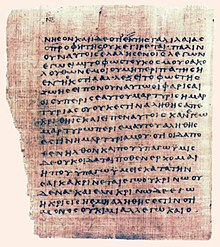Papirüs 4
| Yeni Ahit'in Papirüs El Yazmaları |
|---|
 |
| 1 - 2 - 3 - 4 - 5 - 6 - 7 - 8 - 9 - 10 - 11 - 12 - 13 - 14 - 15 - 16 - 17 - 18 - 19 - 20 - 21 - 22 - 23 - 24 - 25 - 26 - 27 - 28 - 29 - 30 - 31 - 32 - 33 - 34 - 35 - 36 - 37 - 38 - 39 - 40 - 41 - 42 - 43 - 44 - 45 - 46 - 47 - 48 - 49 - 50 - 51 - 52 - 53 - 54 - 55 - 56 - 57 - 58 - 59 - 60 - 61 - 62 - 63 - 64 - 65 - 66 - 67 - 68 - 69 - 70 - 71 - 72 - 73 - 74 - 75 - 76 - 77 - 78 - 79 - 80 - 81 - 82 - 83 - 84 - 85 - 86 - 87 - 88 - 89 - 90 - 91 - 92 - 93 - 94 - 95 - 96 - 97 - 98 - 99 - 100 - 101 - 102 - 103 - 104 - 105 - 106 - 107 - 108 - 109 - 110 - 111 - 112 - 113 - 114 - 115 - 116 - 117 - 118 - 119 - 120 - 121 - 122 - 123 - 124 - 125 - 126 - 127 - 128 - 129 - 130 - 131 - 132 - 133 - 134 - 135 - 136 - 137 - 138 - 139 - 140 - 141 Bu kutu:
|

Papirüs 4 (Gregory-Aland listesine göre: ) Yunanca Kutsal Yazıların (Yeni Ahit) Grekçede yazılan eski bir kopyasıdır. Bu el yazması Luka İncili'nin 1-6 bölümlerinin büyük bir kısmını içermektedir. Bugün Paris'te Bibliothèque nationale de France'ın papirüs koleksiyonunda (Paraf: Suppl. Gr. 1120) saklanır.[1]
Tarih
Bu papirüs Koptos adlı bir şehirde (Mısır) bir duvarın içine gömülmüş bir çöp kutusunda (M.S. 250) bulundu. O, Yahudi filozof Filon'un 3. yüzyılın sonunda yazılmış olan bir kodeksini ciltlemek amacıyla kullanıldı.[2]
'ün metni paleografik yöntemlerle 2. ya da 3. yüzyıla tarihlendirildi. Papirüs 5 ile en eski el yazmaları arasındadır.[3]
Metin
Grekçe yazı İskenderiyeli metin türünü yansıtmaktadır. Bunun için Aland tarafından kategori I'e sıralandı.[4]
Philip Comfort ve David Barret'e göre Papirüs 4 Magdalen papirüsü (, ) gibi aynı kodeksten gelmektedir. Onlar metni M.S. 150-175'e tarihlendirdiler.[5] Bundan başka Comfort ve Barret , ve ile 2. yüzyılın ikinci yarısından gelen başka el yazmaları arasında uygunluklar olduğunu ileri sürerler (örneğin: P. Oxy. 224, 661, 2334, 2404 2750, P. Ryl. 16, 547 ve P. Vindob G 29784).
Ayrıca Roberts,[6] Skeat,[7] ve Stanton[8] Papirüs 4'ün metnini 2. yüzyılın ikinci yarısına tarihlendirirler. 2007'de Charlesworth , ve aynı yazardan kaleme alındıkları halde aynı kodekse ait olmadıklarını tespit etti.[9]
İçerik
Luka 1:58, 59; 1:62 – 2:1; 2:6, 7; 3:8 – 4:2; 4:29-32, 34, 35; 5:3-8; 5:30-6:16 içermektedir.
Kaynakça
- ^ Kurt und Barbara Aland: Der Text des Neuen Testaments. Einführung in die wissenschaftlichen Ausgaben sowie in Theorie und Praxis der modernen Textkritik. Deutsche Bibelgesellschaft, Stuttgart 1989, S. 106. ISBN 3-438-06011-6
- ^ Roberts, Colin. Manuscript, Society, and Belief in Early Christian Egypt Longwood (June 1979) ISBN 0-85672-710-5 pp. 8+23
- ^ Gregory, A. The Reception of Luke and Acts in the Period Before Irenaeus, Mohr Siebeck, (2003) ISBN 3-16-148086-4, S. 28
- ^ Kurt und Barbara Aland: Der Text des Neuen Testaments. Einführung in die wissenschaftlichen Ausgaben sowie in Theorie und Praxis der modernen Textkritik. Deutsche Bibelgesellschaft, Stuttgart 1989, S. 106. ISBN 3-438-06011-6
- ^ Comfort, Philip W. and Barrett, David P. The Text of the Earliest New Testament Greek Manuscripts Wheaton, Ill.: Tyndale House. (2001) S. 50–53
- ^ Roberts, Colin. Manuscript, Society, and Belief in Early Christian Egypt Longwood (June 1979) ISBN 0-85672-710-5 pp. 8+23
- ^ Skeat, T. C. (1997), The Oldest Manuscript of the Four Gospels?, New Test. Stud. 43, S. 1–34.
- ^ Stanton, G. N. (1997), The Fourfold Gospel, New Test. Stud. 43, S. 327
- ^ Charlesworth, S. D.: T. C. Skeat, P64+67 and P4, and the Problem of Fibre Orientation in Codicological Reconstruction, New Testament Studies Vol. 53, Cambridge University Press 2007, S. 582–604
Edebiyat
- Kurt Aland: Kurzgefaßte Liste der griechischen Handschriften des Neuen Testaments – in Verbindung mit Michael Welte bearb. von Kurt Aland. de Gruyter, Berlin/New York 1994, 2. neubearbeitete und ergänzte Auflage, ISBN 3-11-011986-2, (Arbeiten zur neutestamentlichen Textforschung Bd. 1).
- Charlesworth, S. D.: T. C. Skeat, P64+67 and P4, and the Problem of Fibre Orientation in Codicological Reconstruction, New Testament Studies Vol. 53, Cambridge University Press 2007, S. 582–604
- Comfort, Philip W. New Reconstructions and Identifications of New Testament Papyri. In: Novum Testamentum, Vol. 41, Fasc. 3., (Jul., 1999) S. 214–230.
- Comfort, Philip W. and Barrett, David P. The Text of the Earliest New Testament Greek Manuscripts Wheaton, Ill.: Tyndale House. (2001) S. 50–53
- Gregory, A. The Reception of Luke and Acts in the Period Before Irenaeus, Mohr Siebeck, (2003) ISBN 3-16-148086-4, S. 28
- Head, PM (2005), Is P4, P64 and P67 the Oldest Manuscript of the Four Gospels? A Response to T. C. Skeat, New Test. Stud. 51, S. 450–457
- Roberts, Colin. Manuscript, Society, and Belief in Early Christian Egypt Longwood (June 1979) ISBN 0-85672-710-5 pp. 8+23
- Skeat, T. C. (1997), The Oldest Manuscript of the Four Gospels?, New Test. Stud. 43, S. 1–34.
- Stanton, G. N. (1997), The Fourfold Gospel, New Test. Stud. 43, S. 327












